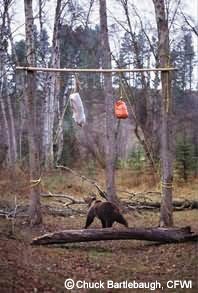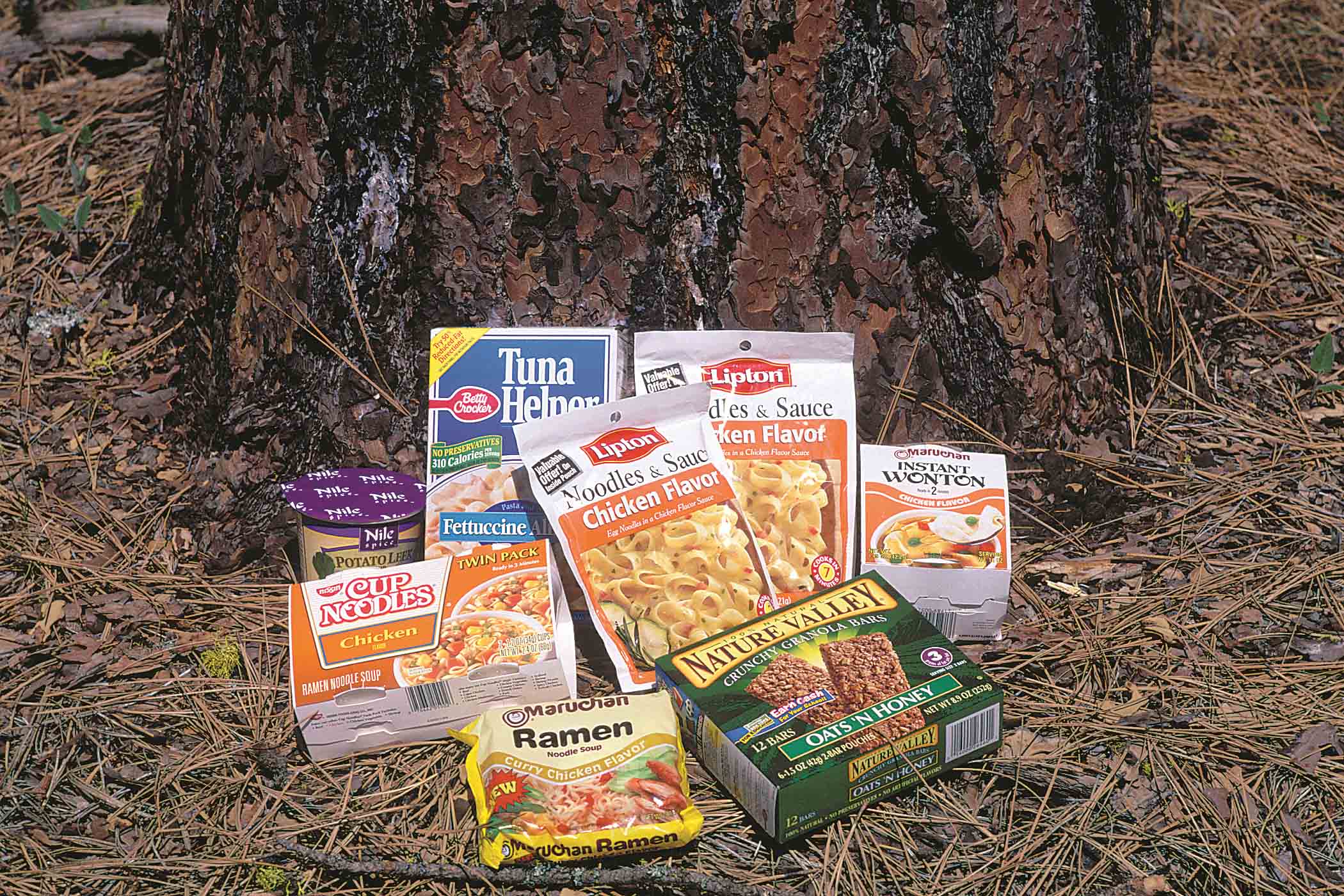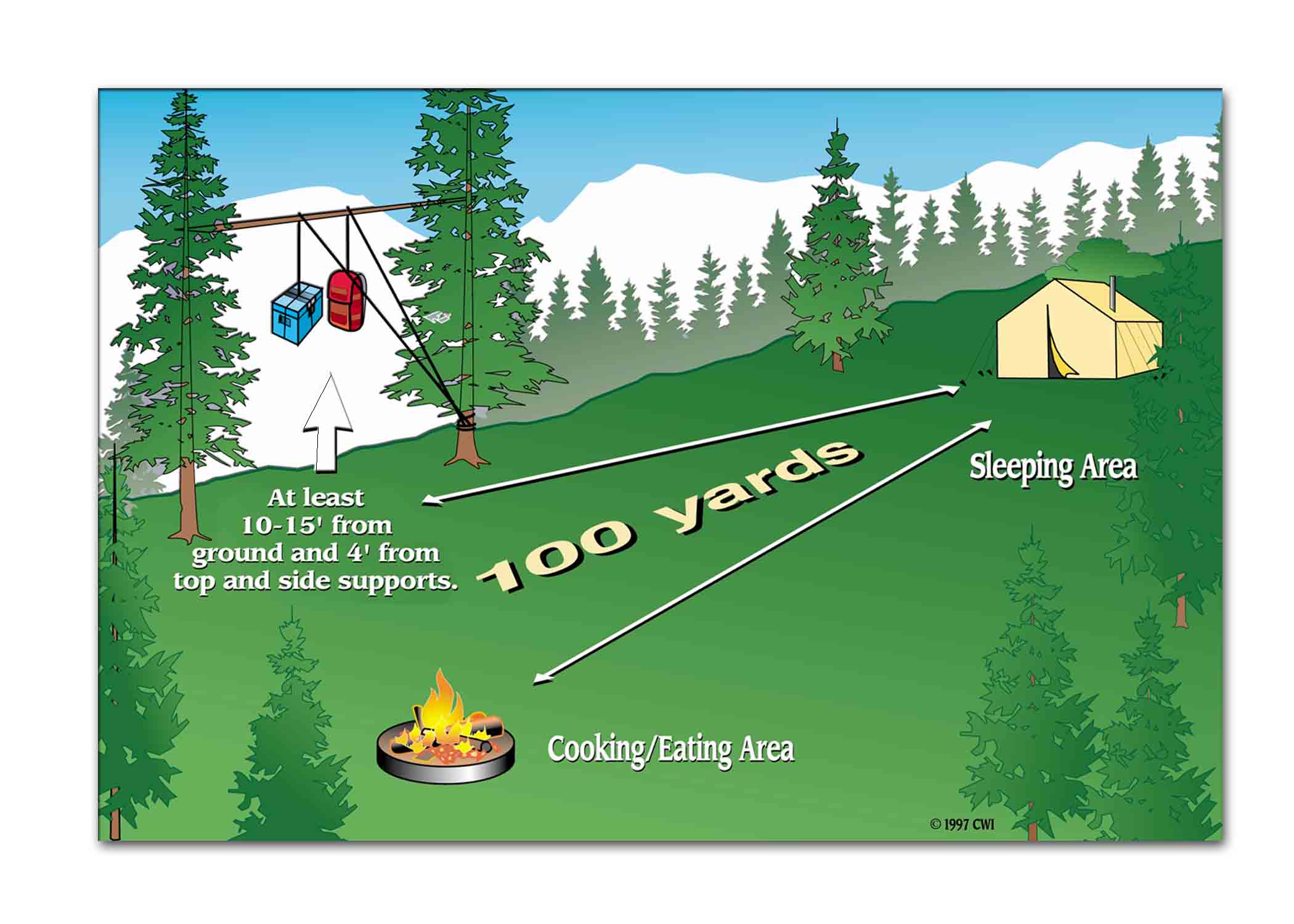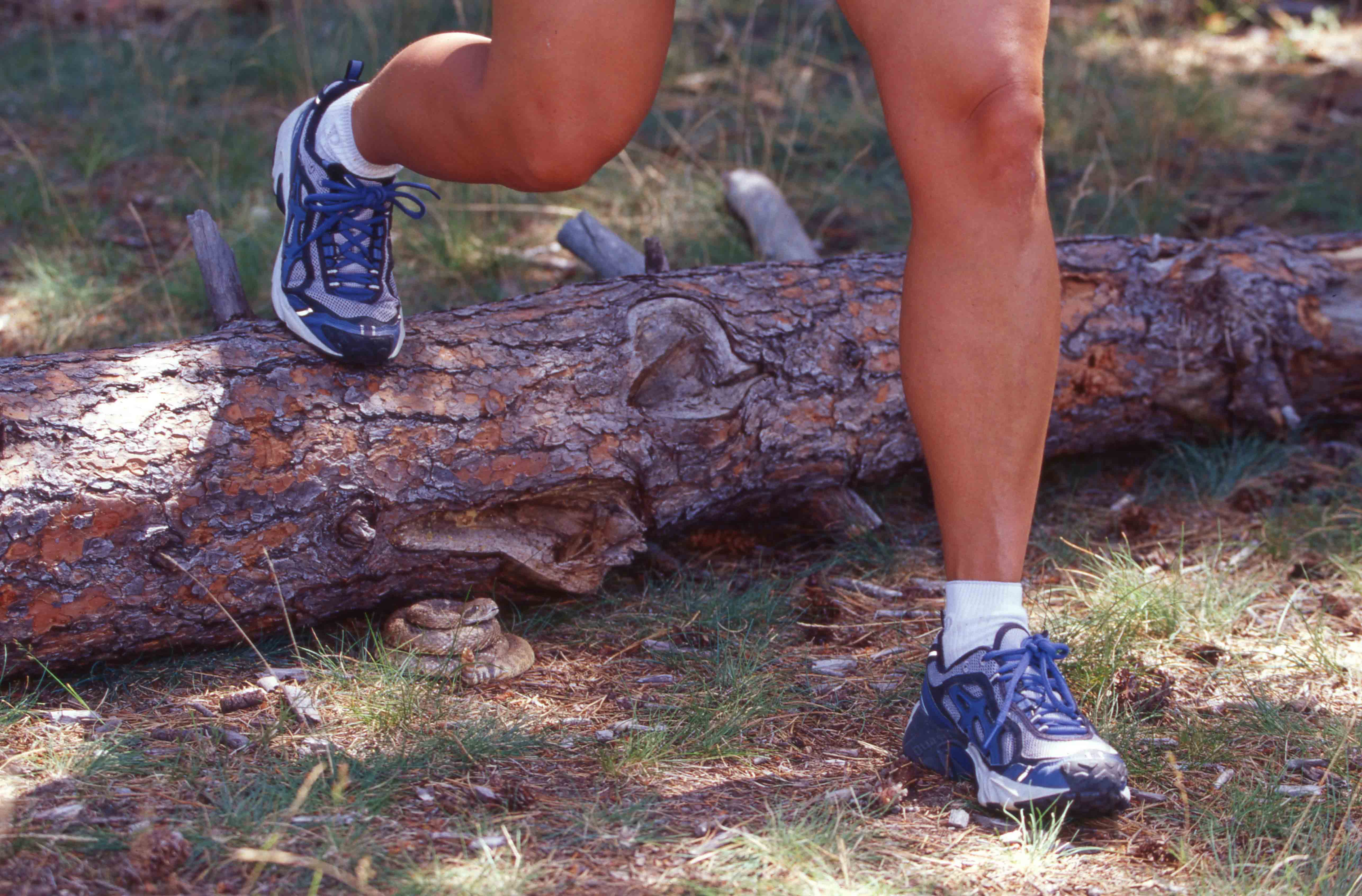Follow Us x
Bear Safety Tips
1) HUNTING & FISHING
Hunting and fishing in bear country requires special equipment, skills, and precautions. Properly prepare for your hunt or fishing trip; and be sure to let someone know where you are going and when you plan to return.
Special Hunter Equipment Checklist:
- EPA registered bear spray - with at least 7 seconds of spray duration and a distance of 30 or more feet. Each hunter or guide should have at least 1 canister.
- Pulley systems and ropes for hanging game and food storage.
- Drop cloth for relocating game.
- Gloves and apron for handling game.
- Cell phone or hand-held 2-way radio, GPS.
- Matches, airhorn, and distress flare.
- First Aid Kit with extra wide bandaging.
- Most recent food storage & game handling regulations.
 Hunters and fishermen need to be very aware of their surroundings as bears and cougars may be very interested in your harvest. Frequently scan the area ahead, beside you, and behind you. Bears, cougars, and rattlesnakes can be hard to see. Remember, you might not be the only hunter out there. Reduce risks of sudden encounters by being alert at all times.
Hunters and fishermen need to be very aware of their surroundings as bears and cougars may be very interested in your harvest. Frequently scan the area ahead, beside you, and behind you. Bears, cougars, and rattlesnakes can be hard to see. Remember, you might not be the only hunter out there. Reduce risks of sudden encounters by being alert at all times.Here are tips to help avoid confrontations with bears.
- Avoid hunting and fishing alone.
- Learn to recognize bear sign, and avoid areas with fresh scat, diggings, tracks, or carcasses.
- Be cautious around berry patches, dense timber or brush, and along creeks and waterfalls as they mask sounds.
- Spawning areas are natural attractions for bears. Bears will aggressively defend a food supply, or the carcass of harvested game.
- Always remain alert for sudden encounters, especially when coming back ashore.
- Carry EPA registered bear spray in a readily accessible area. Be prepared to quickly unholster the cannister, take the safety clip off and spontaneously spray should you have an encounter with a bear or cougar. The recommended spray distance is 30+ feet with a spray duration of at least 7 seconds.
- Keep all food and food-related items inside a closed, hard-sided vehicle or special bear-resistant container except when preparing or eating food. Ice chests, coolers, boxes, cans, tents and soft-sided campers are not bear-resistant!
- Store pet food and livestock feed the same as human food, out of reach from bears and other animals.
- Contain trailer waste-water and dispose of it frequently in the proper facilities.
- Keep pets on a leash while with you or inside a cool, well-ventilated vehicle. Pets may threaten and harass wildlife and can lead predators to your camp. Pets are not allowed on hiking trails in most parks and refuges. Do not leave pets unattended in bear country!
- When walking in a campground at night, always carry bear spray, use a flashlight, and stay alert.
- Ask campers who are not observing precautions to clean up their camp for the safety of other visitors and wildlife.
- Remove all food and garbage from campground storage boxes before you leave.
- Watch for snakes when picking up firewood or gear from the ground.
Sometimes bears are hard to see!


Sometimes bears are easy to see!


Handling Your Game and Fish
- Clean game and fish away from camp, campgrounds, and trails.
- Have bear spray readily available when field-dressing your game or cleaning your fish.
- Wear gloves and apron to minimize odors on clothing. Wash your hands thoroughly, and change clothes when you are through or at least before retiring for the night.
- Separate the carcass from entrails, and remove the carcass from the area as soon as possible.
- Dispose of fish guts properly. Small amounts can be dumped into a fast-moving stream or far out in a large body of water. Pierce the air bladder so that it will sink. Fish guts can also be burned in a very hot fire.
- Never bury fish guts, animals will dig them up.
- Never leave entrails near a trail, campsite, picnic area, or parking lot.
- Carcasses should be kept unavailable to bears by hanging them at least 10 to 15 feet from the ground and 4 feet out from the supporting structure; and 100 yards from any recreation site especially sleeping areas.
- Hang carcass where you can see it from a distance. That way you can observe it as you return.
- Items are considered unavailable to bears if they are:
- Stored in a closed, bear-resistant container.
- Enclosed within a vehicle constructed of solid, non-pliable material.
- Suspended at least 10 to 15 feet from the ground and 4 feet horizontally and vertically from any supporting tree or pole.

Food Regulations
- Human food and beverages, horse feeds, dog food, etc. either in possession or left unattended must be kept unavailable to bears unless being consumed, prepared for consumption, or transported.
- When departing an area, remove all food and refuse from any bear resistant containers left in the area.
- Do not sleep in the same clothes that you handled game or fish in, or cooked in.
- Keep sleeping bags, tents, and sleeping area free of food and beverage odors. Also refrain from having toothpaste, deodorant or other items with an odor.
- Keep bear spray readily available.
- Wash your tent and sleeping bags in unscented detergents.
2) Camping & Food Storage
Backcountry Camping - Always follow all local regulations.
- Learn to recognize bears signs. Do not camp in an area with recent bear signs.
- Camp in an open area away from trails and thick brush.
- Avoid camping where food and garbage are found, or near a bear's natural food source such as a berry patch, fish-spawning stream, or carcass.
- Always sleep in a tent (not under the stars). A tent can be a psychological barrier to a bear.
- Place tents in a line and space tents apart so that animals can travel freely between them and not feel trapped.
- Do not bring your pet, they can draw bears back to you. And, they are usually prohibited in back-country.
- Total cleanliness of yourself and your camp is a must to prevent smells that could attract bears. Avoid scented deodorants, soaps, and cosmetics.
- Avoid cooking odorous foods. Cook downwind and at least 100 yards from where you will sleep.
- Plan meals so that there are no leftovers. Select food in individually sealed packages or store food in airtight containers.

- Set up cooking, eating, and supply areas at least 100 yards from your sleeping area.
- Store food and odorous items by hanging at least 10 to 15 feet above ground and 4 feet from top and side supports or store in approved, bear resistant containers.
- Store pet food, livestock feed and garbage the same as food. Never bury it; pack it out.
- Strain food particles from dishwater using a fine mesh screen and store with garbage.
- Dump dishwater at least 100 yards from your sleeping area. Food odors may attract
- bears and other animals.
- Combustible garbage should be burned completely to eliminate odors.
- Keep sleeping bags and tents completely free of food, food odors and beverages.
- Store personal items (such as deodorants, toothpaste, soap, and lotions) with food and garbage when not in use. Any odorous product may attract bears.
- Do keep your bear spray with you while you cook.
- Do keep bear spray with you in your tent.
- Keep a flashlight and bear spray readily available.
- Wash your hands after cooking, eating, or handling fish or game. Minimize odors.
- Do not sleep in the clothes you cook in.
- Rehearse what you and others in your group will do, day or night, if a bear appears in your camp or while you're hiking. Review local regulations.

- When gathering firewood and picking up belongings off the ground, be cautious of snakes, scorpions, and other insects that are often hard to detect. Rattlesnakes do not always rattle before striking.
- Check for insects in your bedding, clothing, and footwear carefully before using. Also check yourself each evening as sometimes bites may not be felt.
- If a bear enters your campsite or your sleeping and cooking areas seeking food, it is acting in a predatory manner. Get your bear spray ready, group together and retreat to a place of safety. If your attempts from a distance of yelling and throwing things does not cause the bear to retreat, leave the area immediately. Report the incident to the wildlife management agency and retrieve your personal belongings with their assistance.
- If a bear attacks you or a companion in your campsite or eating area, either during the day or night, consider it a predatory confrontation and aggressively fight back with everything possible, including your bear spray. If you cannot spray at the bear, spray the area you are in.
- Do not clean game and fish in or near campgrounds. Wear an apron and be sure to change your clothes afterwards.
- Protect yourself and others and prevent wildlife from obtaining human food and garbage by keeping a clean camp. Deposit all garbage in wildlife-resistant trash containers or in your vehicle if one is not available.
- Keep all food and food-related items inside a closed, hard-sided vehicle or special bear-resistant container except when preparing or eating food. Ice chests, coolers, boxes, cans, tents and soft-sided campers are not bear-resistant!
- Store pet food and livestock feed the same as human food, out of reach from bears and other animals.
- Contain trailer waste-water and dispose of it frequently in the proper facilities.
- Keep pets on a leash while with you or inside a cool, well-ventilated vehicle. Pets may threaten and harass wildlife and can lead predators to your camp. Pets are not allowed on hiking trails in most parks and refuges. Do not leave pets unattended in bear country!
- When walking in a campground at night, always carry bear spray, use a flashlight, and stay alert.
- Ask campers who are not observing precautions to clean up their camp for the safety of other visitors and wildlife.
- Remove all food and garbage from campground storage boxes before you leave.
- Watch for snakes when picking up firewood or gear from the ground.
3) Campgrounds
- Don't be careless with food or garbage when camping in a campground.
- Wild animals, especially bears, may wander through at any time of day or night.
- Wildlife near a campground are more likely to be habituated or food-conditioned (used to people and their food).
- Having lost their natural fear of humans, these animals often become increasingly aggressive in their attempts to obtain human, pet, and livestock food.
- Always keep a clean camp.
Use a designated camping area and set up tents with space between them -not in a circle. This gives wildlife the ability to travel freely between them and not feel trapped.
Keep a flashlight and bear spray readily available.
Wild animals traveling through campgrounds should never be assumed to be tame and should not be approached or fed.
Immediately notify the campground host if you encounter a bear, cougar, or rattlesnake in or near your campground area.

- Do not clean game and fish in or near campgrounds. Wear an apron and be sure to change your clothes afterwards.
- Protect yourself and others and prevent wildlife from obtaining human food and garbage by keeping a clean camp. Deposit all garbage in wildlife-resistant trash containers or in your vehicle if one is not available.
Food Regulations
Human food and beverages, horse feeds, dog food, garbage, etc. - either in possession or left unattended - must be kept unavailable to bears unless being consumed, prepared for consumption, or transported.
Items are considered unavailable to bears if they are:
- Stored in a closed, bear-resistant container.
- Enclosed within a vehicle constructed of solid, non-pliable material.
- Suspended at least 10 to 15 feet from the ground and 4 feet horizontally and vertically from any supporting tree or pole.
- Do not sleep in the same clothes that you handled fish or game or cooked in.
- Keep sleeping bags, tents, and sleeping area free of food and beverage odors. Keep in mind that toothpaste, deodorant, and lotions are also odorous and can attract bears.
- Keep bear spray readily available.
- When departing an area, remove all food and refuse from any bear resistant containers left in the area.
4) Hiking, Biking & Boating
Whether you hike, mountain bike, float rivers or ride horses, there are precautions you should take. Start by telling someone where you are going and when you plan to return.
Always follow local regulations and review trailhead signs.
Following the suggestions below will help make the journey safer for you, your companions, and wildlife. Bear country can also be home to cougars, snakes> and other wildlife, such as bison, moose, deer and elk. All wild animals can be dangerous. Look for bear signs in your immediate area; and always maintain a safe and respectful distance from wildlife. Please do not approach, follow, or feed wildlife, especially bears.
Reduce the risk of close encounters:
Make Noise: Talk or call out in a monotone, non-threatening voice, sing, or clap your hands to let a bear know of your presence. Don't rely on bells, usually they are too quiet and a bear can become desensitized to them. Shout often when traveling upwind, near streams and waterfalls, or when you cannot see the path ahead. (Avoid thick brush.)
Be Alert: Watch for bear signs such as tracks, droppings, diggings, rocks rolled over, scratch marks on trees, and logs torn apart. Carry binoculars and scan ahead periodically.
Don't Hike Alone or at Night: Bears and cougars are most active at dawn, dusk and night, but can be encountered any time. Groups of three or more people tend to make more noise and appear more formidable. This makes groups safer than solo hikers.
Stay on Trails for your safety and to protect the habitat.
Avoid Carcasses: Report dead animals to the nearest ranger station. It is very risky to approach a carcass; a bear may be just out of sight, guarding its food.
Avoid Odorous Items: Leave foods and beverages with strong odors, scented deodorants, lotions, and other odorous items at home. A bear's acute sense of smell can detect odors from great distances. Dry foods are both lighter and less smelly.
Stay with Your Gear: Don't leave your packs, food, or beverages unattended; even food or beverages stored under water may attract bears.
Taking Pets on Hiking Trails is Not Advised: Pets may attract bears and cougars and are not allowed on trails in our national parks and refuges. If dogs are permitted, keep them on a short leash to avoid conflicts with wildlife.
Bicyclists and Runners should carefully select the areas they are recreating in and be extra alert in cougar, bear, and rattlesnake country. Speed and quietness increase risks of a sudden encounter. Wearing ear buds and listening devices should be avoided as it drowns out sounds around you.
Hike at a pace everyone can maintain and stay together. Cougars and some bears behave in a predatory manner and will seek the easiest target. Don't hike ahead or allow someone to fall behind, especially children and pets.
Running to a tree may provoke a bear or cougar to chase you. You cannot outrun them. Bears can run up to 35 mph, up and downhill, while cougars are known for their powerful sprints and jumps. Climb a tree only if it is near and the animal far away. Keep in mind that all black bears and some grizzlies climb trees.  Rattlesnakes are very seldom seen. They can sense our vibrations from walking and look for a place to hide, which is often behind rocks, logs or in thick brush. They are usually not aggressive unless they are directly threatened, either deliberately or by accident. Rattlesnakes do not always rattle before striking. To prevent being bitten avoid stepping directly in front of or behind logs and rocks (step on top and away). Before sitting down or picking up supplies from the ground, look around the area carefully. Watch where you put your hands and feet. Most importantly, enjoy snakes at a distance without disturbing them.
Rattlesnakes are very seldom seen. They can sense our vibrations from walking and look for a place to hide, which is often behind rocks, logs or in thick brush. They are usually not aggressive unless they are directly threatened, either deliberately or by accident. Rattlesnakes do not always rattle before striking. To prevent being bitten avoid stepping directly in front of or behind logs and rocks (step on top and away). Before sitting down or picking up supplies from the ground, look around the area carefully. Watch where you put your hands and feet. Most importantly, enjoy snakes at a distance without disturbing them.
Alligators are found throughout the southeast and as far west as Texas. Crocodiles are found in parts of Florida. Both prefer to avoid people and will often retreat to water when disturbed. However, mother alligators will aggressively defend their nest and may chase intruders away. Be extra careful around shorelines as they may lay in wait for game. Be aware of trails or drag marks indicating a regularly traveled route.
5) RESIDENTIAL AREAS
- Minimize odors and the availability of food rewards throughout your yard and neighborhood. Report all residential wildlife encounters to your local wildlife management agency and police department, and notify your neighbors of the situation.
- Remove any dense brush that could provide cover for a bear or cougar and make a surprise encounter likely. Also remove brush piles that snakes may hide in.

Bear activity may intensify in the spring when bears are hungry and emerging from their dens, in the fall when bears are bulking up for hibernation, and during drought periods. This is due to natural foods often being scarce.
6) VIEWING & PHOTOGRAPHING WILDLIFE
 View and photograph from established observation areas or the trail when hiking. If an animal approaches, back away in order to maintain a safe distance. You should stay at least 100 yards away from bears and 25 yards away from large wildlife such as bison, moose, elk, and deer.
View and photograph from established observation areas or the trail when hiking. If an animal approaches, back away in order to maintain a safe distance. You should stay at least 100 yards away from bears and 25 yards away from large wildlife such as bison, moose, elk, and deer.
- Use binoculars, spotting scopes and telephoto lenses to view and photograph wildlife. This reduces stress on the animals.
- Remain alert to potential danger while viewing or taking pictures.
- Avoid direct eye contact with bears, even through a lens, because it may be interpreted as a challenge or threat.
- Stay away from newborn or young animals, nests, and dens.
- Never sneak up on or surprise an animal, especially a bear.
- Never surround, crowd, chase, or follow an animal. It may respond by charging.
- Never try to get an animal to move to a different location.
- Watch other people in the area. Are they putting you in danger?
- Allow other visitors to enjoy wildlife - avoid blocking others' views.
- Don't make sudden movements or loud noises around wild animals.
Professional Photographers Get Great Photos by:
- Using appropriate telephoto lenses, and by cropping their photographs.
- Photographing in controlled wildlife management areas with special access permits.
- Being patient, practicing low-impact photography and devoting many years to getting desired photos.
- Using captive and conditioned animals at zoos and game farms.

